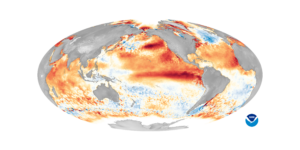
Scientists record global ocean temperatures using satellite observations. Since mid-March, the global average sea surface temperature has been more than 70 degrees, a record high temperature. This indicates rapid warming, which is associated with global warming and ocean circulations.
El Niño and La Niña are climate patterns in the Pacific Ocean. Normally, the trade winds blow west along the equator, moving warm water from South America toward Asia. To replace that warm water, cold water rises from the ocean depths — a process called upwelling. That means cold water rises to the surface near South America.
During La Niña events, trade winds are stronger than usual, pushing more warm water toward Asia and stronger upwelling. La Niña causes water in the eastern Pacific to be colder than usual. During El Niño, trade winds weaken, and warm water is pushed back toward the west coast of the Americas. El Niño causes the ocean surface water to be warmer than average.
A La Niña pattern has been in place for the last three years. Observations indicate the Pacific Ocean is switching to an El Niño pattern, which is contributing to the warming ocean surface temperatures.
We associate El Niño conditions with certain weather patterns across the globe. Over North America, the jet stream is weaker and farther north during the summer months, minimizing the effects of El Niño on weather in the United States.
The impacts of El Niño in temperate latitudes are most evident during winter. A weak polar jet stream forms over eastern Canada, and as a result, a large part of North America is warmer than normal. Changes in precipitation and temperature patterns caused by El Niño affect snowfall in the United States, reducing total winter snowfall in the Midwest and New England regions.
Steve Ackerman and Jonathan Martin, professors in the UW-Madison department of atmospheric and oceanic sciences, are guests on WHA radio (970 AM) at 11:45 a.m. the last Monday of each month. Send them your questions at stevea@ssec.wisc.edu or jemarti1@wisc.edu.

